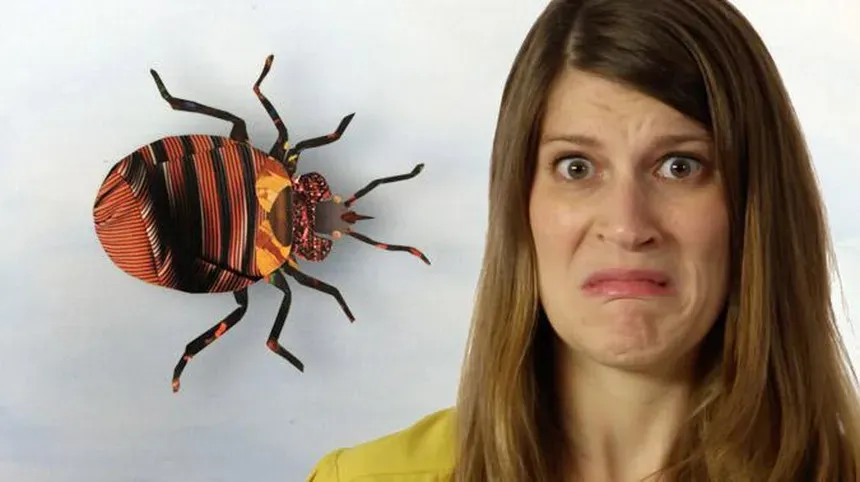Gross Science
Are Bees the Addicts of the Animal Kingdom?
Season 2 Episode 31 | 4m 16sVideo has Closed Captions
Bees get more than just nectar from the flowers they visit.
Bees get more than just nectar from the flowers they visit. Sometimes they also get a sip of caffeine, nicotine, or alcohol.
Problems with Closed Captions? Closed Captioning Feedback
Problems with Closed Captions? Closed Captioning Feedback
Gross Science
Are Bees the Addicts of the Animal Kingdom?
Season 2 Episode 31 | 4m 16sVideo has Closed Captions
Bees get more than just nectar from the flowers they visit. Sometimes they also get a sip of caffeine, nicotine, or alcohol.
Problems with Closed Captions? Closed Captioning Feedback
How to Watch Gross Science
Gross Science is available to stream on pbs.org and the free PBS App, available on iPhone, Apple TV, Android TV, Android smartphones, Amazon Fire TV, Amazon Fire Tablet, Roku, Samsung Smart TV, and Vizio.

Gross Science on Tumblr
Hi, I'm Anna. I host a YouTube series for NOVA, PBS Digital Studios, and WGBH on the slimy, smelly, creepy world of science. Here I post about all things bizarre and beautiful.Providing Support for PBS.org
Learn Moreabout PBS online sponsorshipHoneybees are known as the hard workers of the animal kingdom.
But sometimes they like to party.
Maybe a little too hard.
I'm Anna and this is Gross Science.
Honeybees have to visit about two million flowers to collect enough nectar to make just one pound of honey.
They're one of nature's best pollinators.
In fact, many plants rely heavily on honeybee pollination for their survival, so they've evolved to produce particularly delicious nectar to lure in the bees.
Certain plants offer more than just nectar, though.
Some also produce low-levels of caffeine and nicotine.
The plants may have originally used these substances to fend off unwanted predators, because nicotine and caffeine can taste pretty bitter.
But it turns out that, at certain doses, honeybees may actually like them.
In fact, a study at the University of Haifa found that honeybees preferred collecting nectar from flowers with caffeine and nicotine, compared to flowers without it.
And years of plant evolution may have selected for levels of caffeine and nicotine that most appeal to bees in order to ensure pollination.
Now, that doesn't necessarily mean the bees were "addicted" to caffeine or nicotine, it just means they had a clear preference.
That said, these substances can affect bees' decision-making.
Researchers at the University of Sussex conducted a different study with caffeine-laced feeders.
They trained bees to collect sucrose solutions at two separate feeders - one that was caffeinated, and one that wasn't.
The bees foraging at the caffeinated feeder went on many more collecting trips, even though the caffeinated nectar contained exactly the same amount of sugar as the uncaffeinated one.
They also recruited more bees from the hive to visit the caffeinated food source.
Now, you'd think this would be a good thing.
More trips mean more honey, right?
Well, not necessarily.
If bees in the wild like caffeine so much that they'd choose caffeinated flowers with less sugar over uncaffeinated flowers with more sugar, that could hurt the hive.
The bees might actually be producing less honey, despite the additional trips.
Besides caffeine, bees will also drink alcohol.
Honeybees are known to get drunk off alcoholic tree sap or fermented nectar.
Bees that feed on fermented nectar can lose the ability to fly and remember their way back to the hive.
And since bees can travel more than four miles away to forage, this can be dangerous.
They may end up getting lost, and sometimes even die trying to find their way back to the hive.
What's interesting is that the honeybee's reaction to alcohol is similar to humans.
A group of researchers from Ohio State University put this to the test, by feeding ethanol to honeybees and studying their behavior.
The honeybees were separated into different groups and given different amounts of ethanol.
Within the first 10 minutes, the bees were showing signs of inebriation.
Some spent most of their time chilling.
Some lost postural control, unable to stand upright, or fly.
Some were so drunk, they couldn't flip off their backs.
The higher amount of ethanol they consumed, the drunker they got.
Some scientists think that by studying drunk bees, we might one day learn how to counteract the urge to drink in alcoholics.
But while this is exciting for the future of substance abuse research, one thing is clear.
Getting wasted is never cool, whether you're a person or a honeybee.
Ew.
Support for PBS provided by:












